Critical Reflection: Healthcare Professional Communication
VerifiedAdded on 2023/06/10
|9
|2276
|224
AI Summary
This critical reflection discusses the resistance to changes in policies and procedures in a psychiatric intensive care unit and the importance of effective communication among healthcare professionals. It also highlights the legal obligations of healthcare employees to provide a healthy and safe environment for themselves and patients.
Contribute Materials
Your contribution can guide someone’s learning journey. Share your
documents today.

Running Head: CRITICAL REFLECTION: HEALTHCARE PROFESSIONAL
COMMUNICATION 1
Critical Reflection: Healthcare Professional Communication
Name
Student number
Unit code
Unit coordinator
Institution
Date
Word count
COMMUNICATION 1
Critical Reflection: Healthcare Professional Communication
Name
Student number
Unit code
Unit coordinator
Institution
Date
Word count
Secure Best Marks with AI Grader
Need help grading? Try our AI Grader for instant feedback on your assignments.
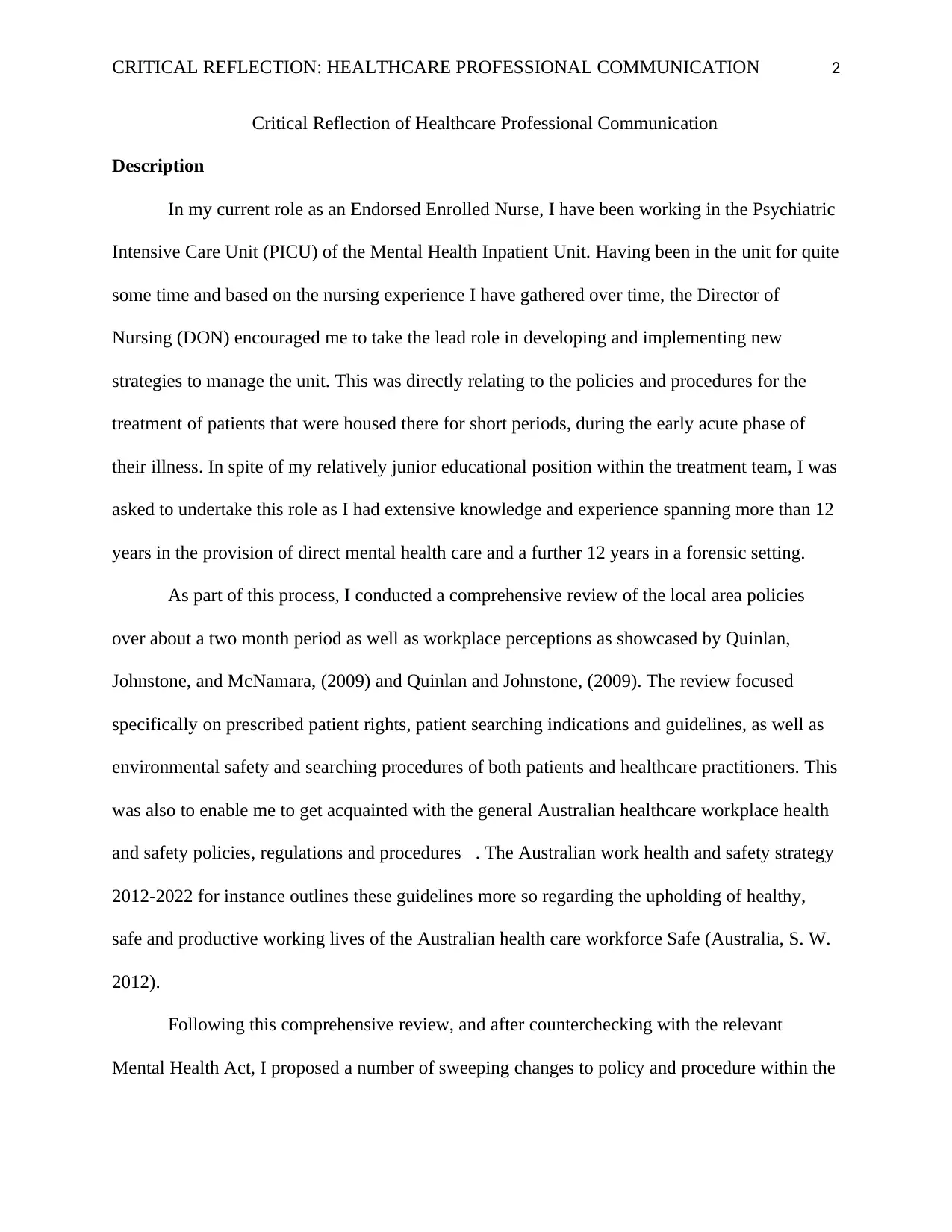
CRITICAL REFLECTION: HEALTHCARE PROFESSIONAL COMMUNICATION 2
Critical Reflection of Healthcare Professional Communication
Description
In my current role as an Endorsed Enrolled Nurse, I have been working in the Psychiatric
Intensive Care Unit (PICU) of the Mental Health Inpatient Unit. Having been in the unit for quite
some time and based on the nursing experience I have gathered over time, the Director of
Nursing (DON) encouraged me to take the lead role in developing and implementing new
strategies to manage the unit. This was directly relating to the policies and procedures for the
treatment of patients that were housed there for short periods, during the early acute phase of
their illness. In spite of my relatively junior educational position within the treatment team, I was
asked to undertake this role as I had extensive knowledge and experience spanning more than 12
years in the provision of direct mental health care and a further 12 years in a forensic setting.
As part of this process, I conducted a comprehensive review of the local area policies
over about a two month period as well as workplace perceptions as showcased by Quinlan,
Johnstone, and McNamara, (2009) and Quinlan and Johnstone, (2009). The review focused
specifically on prescribed patient rights, patient searching indications and guidelines, as well as
environmental safety and searching procedures of both patients and healthcare practitioners. This
was also to enable me to get acquainted with the general Australian healthcare workplace health
and safety policies, regulations and procedures . The Australian work health and safety strategy
2012-2022 for instance outlines these guidelines more so regarding the upholding of healthy,
safe and productive working lives of the Australian health care workforce Safe (Australia, S. W.
2012).
Following this comprehensive review, and after counterchecking with the relevant
Mental Health Act, I proposed a number of sweeping changes to policy and procedure within the
Critical Reflection of Healthcare Professional Communication
Description
In my current role as an Endorsed Enrolled Nurse, I have been working in the Psychiatric
Intensive Care Unit (PICU) of the Mental Health Inpatient Unit. Having been in the unit for quite
some time and based on the nursing experience I have gathered over time, the Director of
Nursing (DON) encouraged me to take the lead role in developing and implementing new
strategies to manage the unit. This was directly relating to the policies and procedures for the
treatment of patients that were housed there for short periods, during the early acute phase of
their illness. In spite of my relatively junior educational position within the treatment team, I was
asked to undertake this role as I had extensive knowledge and experience spanning more than 12
years in the provision of direct mental health care and a further 12 years in a forensic setting.
As part of this process, I conducted a comprehensive review of the local area policies
over about a two month period as well as workplace perceptions as showcased by Quinlan,
Johnstone, and McNamara, (2009) and Quinlan and Johnstone, (2009). The review focused
specifically on prescribed patient rights, patient searching indications and guidelines, as well as
environmental safety and searching procedures of both patients and healthcare practitioners. This
was also to enable me to get acquainted with the general Australian healthcare workplace health
and safety policies, regulations and procedures . The Australian work health and safety strategy
2012-2022 for instance outlines these guidelines more so regarding the upholding of healthy,
safe and productive working lives of the Australian health care workforce Safe (Australia, S. W.
2012).
Following this comprehensive review, and after counterchecking with the relevant
Mental Health Act, I proposed a number of sweeping changes to policy and procedure within the
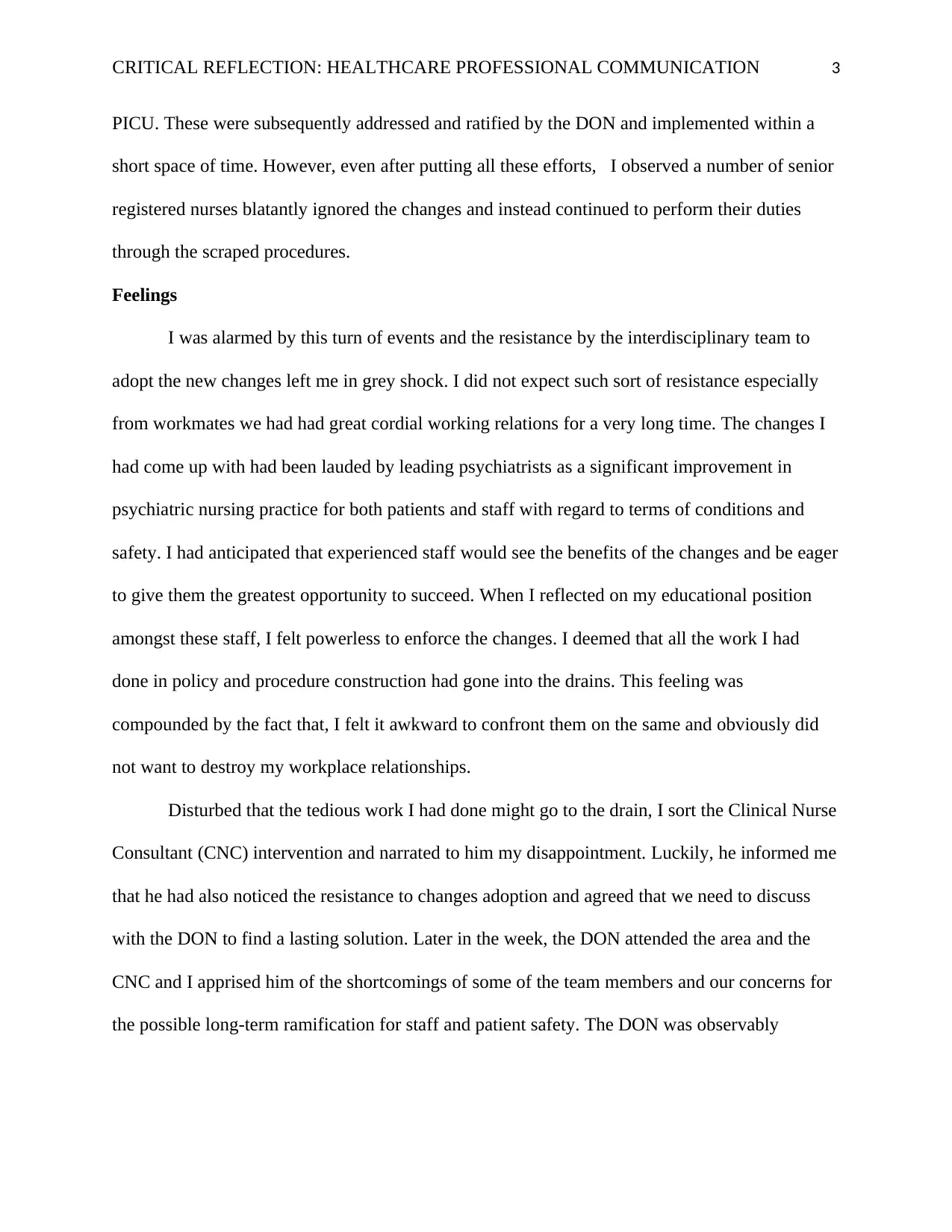
CRITICAL REFLECTION: HEALTHCARE PROFESSIONAL COMMUNICATION 3
PICU. These were subsequently addressed and ratified by the DON and implemented within a
short space of time. However, even after putting all these efforts, I observed a number of senior
registered nurses blatantly ignored the changes and instead continued to perform their duties
through the scraped procedures.
Feelings
I was alarmed by this turn of events and the resistance by the interdisciplinary team to
adopt the new changes left me in grey shock. I did not expect such sort of resistance especially
from workmates we had had great cordial working relations for a very long time. The changes I
had come up with had been lauded by leading psychiatrists as a significant improvement in
psychiatric nursing practice for both patients and staff with regard to terms of conditions and
safety. I had anticipated that experienced staff would see the benefits of the changes and be eager
to give them the greatest opportunity to succeed. When I reflected on my educational position
amongst these staff, I felt powerless to enforce the changes. I deemed that all the work I had
done in policy and procedure construction had gone into the drains. This feeling was
compounded by the fact that, I felt it awkward to confront them on the same and obviously did
not want to destroy my workplace relationships.
Disturbed that the tedious work I had done might go to the drain, I sort the Clinical Nurse
Consultant (CNC) intervention and narrated to him my disappointment. Luckily, he informed me
that he had also noticed the resistance to changes adoption and agreed that we need to discuss
with the DON to find a lasting solution. Later in the week, the DON attended the area and the
CNC and I apprised him of the shortcomings of some of the team members and our concerns for
the possible long-term ramification for staff and patient safety. The DON was observably
PICU. These were subsequently addressed and ratified by the DON and implemented within a
short space of time. However, even after putting all these efforts, I observed a number of senior
registered nurses blatantly ignored the changes and instead continued to perform their duties
through the scraped procedures.
Feelings
I was alarmed by this turn of events and the resistance by the interdisciplinary team to
adopt the new changes left me in grey shock. I did not expect such sort of resistance especially
from workmates we had had great cordial working relations for a very long time. The changes I
had come up with had been lauded by leading psychiatrists as a significant improvement in
psychiatric nursing practice for both patients and staff with regard to terms of conditions and
safety. I had anticipated that experienced staff would see the benefits of the changes and be eager
to give them the greatest opportunity to succeed. When I reflected on my educational position
amongst these staff, I felt powerless to enforce the changes. I deemed that all the work I had
done in policy and procedure construction had gone into the drains. This feeling was
compounded by the fact that, I felt it awkward to confront them on the same and obviously did
not want to destroy my workplace relationships.
Disturbed that the tedious work I had done might go to the drain, I sort the Clinical Nurse
Consultant (CNC) intervention and narrated to him my disappointment. Luckily, he informed me
that he had also noticed the resistance to changes adoption and agreed that we need to discuss
with the DON to find a lasting solution. Later in the week, the DON attended the area and the
CNC and I apprised him of the shortcomings of some of the team members and our concerns for
the possible long-term ramification for staff and patient safety. The DON was observably
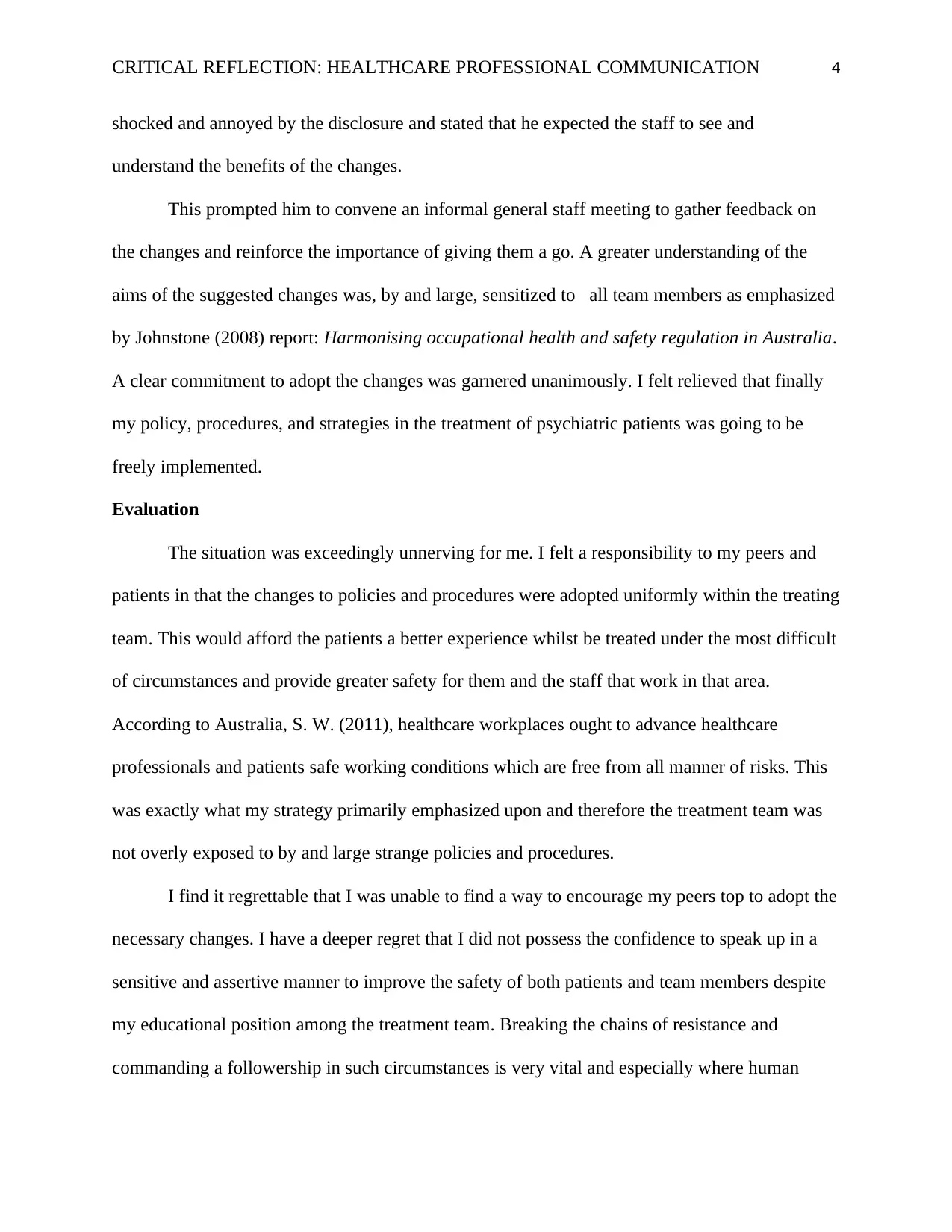
CRITICAL REFLECTION: HEALTHCARE PROFESSIONAL COMMUNICATION 4
shocked and annoyed by the disclosure and stated that he expected the staff to see and
understand the benefits of the changes.
This prompted him to convene an informal general staff meeting to gather feedback on
the changes and reinforce the importance of giving them a go. A greater understanding of the
aims of the suggested changes was, by and large, sensitized to all team members as emphasized
by Johnstone (2008) report: Harmonising occupational health and safety regulation in Australia.
A clear commitment to adopt the changes was garnered unanimously. I felt relieved that finally
my policy, procedures, and strategies in the treatment of psychiatric patients was going to be
freely implemented.
Evaluation
The situation was exceedingly unnerving for me. I felt a responsibility to my peers and
patients in that the changes to policies and procedures were adopted uniformly within the treating
team. This would afford the patients a better experience whilst be treated under the most difficult
of circumstances and provide greater safety for them and the staff that work in that area.
According to Australia, S. W. (2011), healthcare workplaces ought to advance healthcare
professionals and patients safe working conditions which are free from all manner of risks. This
was exactly what my strategy primarily emphasized upon and therefore the treatment team was
not overly exposed to by and large strange policies and procedures.
I find it regrettable that I was unable to find a way to encourage my peers top to adopt the
necessary changes. I have a deeper regret that I did not possess the confidence to speak up in a
sensitive and assertive manner to improve the safety of both patients and team members despite
my educational position among the treatment team. Breaking the chains of resistance and
commanding a followership in such circumstances is very vital and especially where human
shocked and annoyed by the disclosure and stated that he expected the staff to see and
understand the benefits of the changes.
This prompted him to convene an informal general staff meeting to gather feedback on
the changes and reinforce the importance of giving them a go. A greater understanding of the
aims of the suggested changes was, by and large, sensitized to all team members as emphasized
by Johnstone (2008) report: Harmonising occupational health and safety regulation in Australia.
A clear commitment to adopt the changes was garnered unanimously. I felt relieved that finally
my policy, procedures, and strategies in the treatment of psychiatric patients was going to be
freely implemented.
Evaluation
The situation was exceedingly unnerving for me. I felt a responsibility to my peers and
patients in that the changes to policies and procedures were adopted uniformly within the treating
team. This would afford the patients a better experience whilst be treated under the most difficult
of circumstances and provide greater safety for them and the staff that work in that area.
According to Australia, S. W. (2011), healthcare workplaces ought to advance healthcare
professionals and patients safe working conditions which are free from all manner of risks. This
was exactly what my strategy primarily emphasized upon and therefore the treatment team was
not overly exposed to by and large strange policies and procedures.
I find it regrettable that I was unable to find a way to encourage my peers top to adopt the
necessary changes. I have a deeper regret that I did not possess the confidence to speak up in a
sensitive and assertive manner to improve the safety of both patients and team members despite
my educational position among the treatment team. Breaking the chains of resistance and
commanding a followership in such circumstances is very vital and especially where human
Secure Best Marks with AI Grader
Need help grading? Try our AI Grader for instant feedback on your assignments.
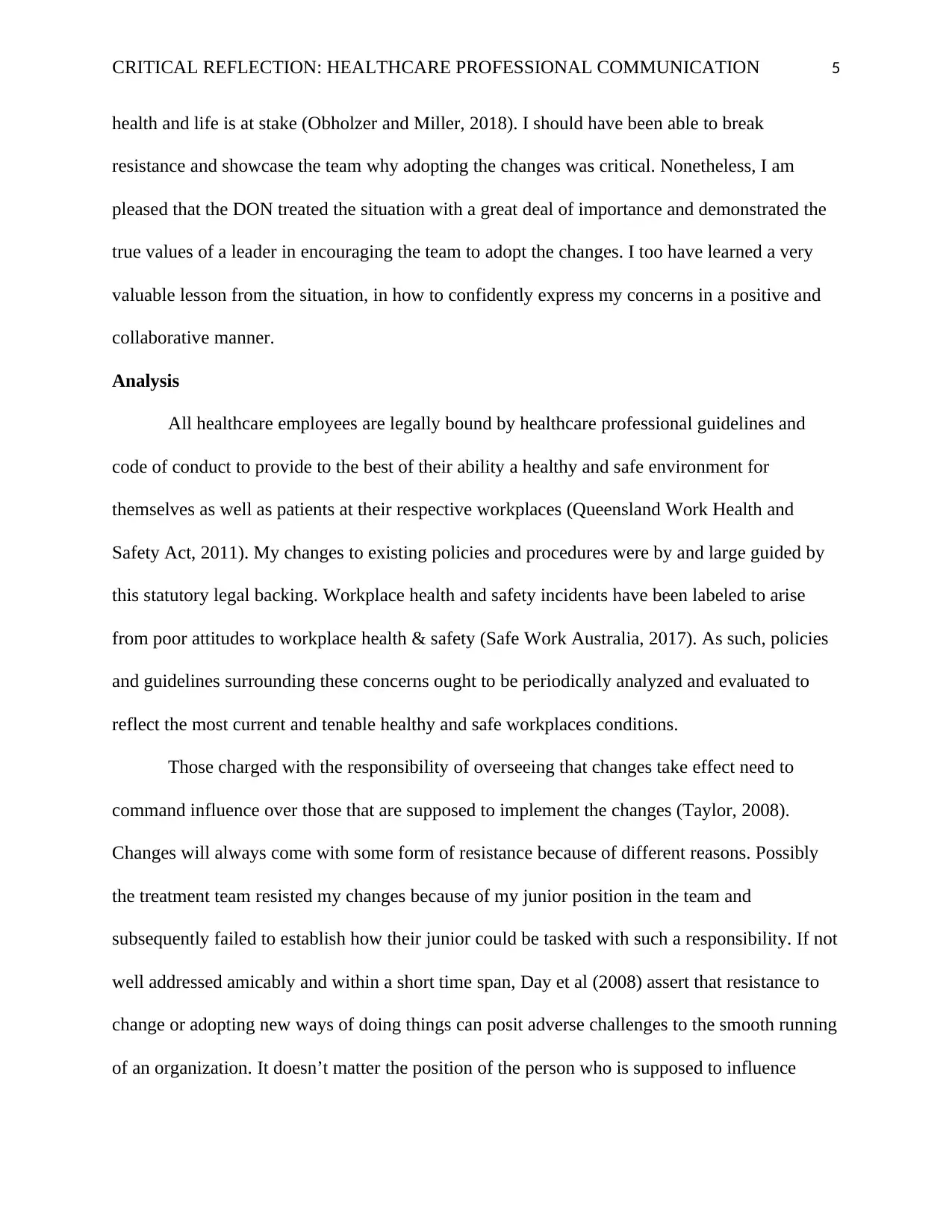
CRITICAL REFLECTION: HEALTHCARE PROFESSIONAL COMMUNICATION 5
health and life is at stake (Obholzer and Miller, 2018). I should have been able to break
resistance and showcase the team why adopting the changes was critical. Nonetheless, I am
pleased that the DON treated the situation with a great deal of importance and demonstrated the
true values of a leader in encouraging the team to adopt the changes. I too have learned a very
valuable lesson from the situation, in how to confidently express my concerns in a positive and
collaborative manner.
Analysis
All healthcare employees are legally bound by healthcare professional guidelines and
code of conduct to provide to the best of their ability a healthy and safe environment for
themselves as well as patients at their respective workplaces (Queensland Work Health and
Safety Act, 2011). My changes to existing policies and procedures were by and large guided by
this statutory legal backing. Workplace health and safety incidents have been labeled to arise
from poor attitudes to workplace health & safety (Safe Work Australia, 2017). As such, policies
and guidelines surrounding these concerns ought to be periodically analyzed and evaluated to
reflect the most current and tenable healthy and safe workplaces conditions.
Those charged with the responsibility of overseeing that changes take effect need to
command influence over those that are supposed to implement the changes (Taylor, 2008).
Changes will always come with some form of resistance because of different reasons. Possibly
the treatment team resisted my changes because of my junior position in the team and
subsequently failed to establish how their junior could be tasked with such a responsibility. If not
well addressed amicably and within a short time span, Day et al (2008) assert that resistance to
change or adopting new ways of doing things can posit adverse challenges to the smooth running
of an organization. It doesn’t matter the position of the person who is supposed to influence
health and life is at stake (Obholzer and Miller, 2018). I should have been able to break
resistance and showcase the team why adopting the changes was critical. Nonetheless, I am
pleased that the DON treated the situation with a great deal of importance and demonstrated the
true values of a leader in encouraging the team to adopt the changes. I too have learned a very
valuable lesson from the situation, in how to confidently express my concerns in a positive and
collaborative manner.
Analysis
All healthcare employees are legally bound by healthcare professional guidelines and
code of conduct to provide to the best of their ability a healthy and safe environment for
themselves as well as patients at their respective workplaces (Queensland Work Health and
Safety Act, 2011). My changes to existing policies and procedures were by and large guided by
this statutory legal backing. Workplace health and safety incidents have been labeled to arise
from poor attitudes to workplace health & safety (Safe Work Australia, 2017). As such, policies
and guidelines surrounding these concerns ought to be periodically analyzed and evaluated to
reflect the most current and tenable healthy and safe workplaces conditions.
Those charged with the responsibility of overseeing that changes take effect need to
command influence over those that are supposed to implement the changes (Taylor, 2008).
Changes will always come with some form of resistance because of different reasons. Possibly
the treatment team resisted my changes because of my junior position in the team and
subsequently failed to establish how their junior could be tasked with such a responsibility. If not
well addressed amicably and within a short time span, Day et al (2008) assert that resistance to
change or adopting new ways of doing things can posit adverse challenges to the smooth running
of an organization. It doesn’t matter the position of the person who is supposed to influence

CRITICAL REFLECTION: HEALTHCARE PROFESSIONAL COMMUNICATION 6
change is, the fact is that as long as such persons are in a position to build trust with co-workers;
are assertive; flexible; are personal; emphatic and willing to listen to others’ opinions, then
change resistance can be greatly minimized. This is the greatest lesson I derived from the DON.
Conclusion
Resistance to my policies and procedures might have emanated from the fact that I did
not involve the treatment team in the planning and development of the same. I ought to have
included them if was to command any respect and influence. This is the greatest lesson I have
learned from this communication scenario. Though I was given the opportunity to come up with
the policies and procedures, I ought to have incorporated the whole treatment team in their
development. Bambling et al, (2007) assert that such factors are what contribute to the
challenges of advancing quality psychiatric healthcare in rural Queensland. This reflection has
opened my viewpoint concerning the power of teamwork in the achievement of group or
organizational goals; a virtue I will embrace in future tasks.
Action Plan
My future considerations would be a willingness to develop my confidence and
assertiveness when dealing with peers regardless of my position amongst them. This is with the
vivid realization that it doesn’t matter of an employee’s position to influence changes in an
organization. I possibly need to attend leadership and management sessions to equip myself with
the requisite leadership and management skills to be in a position to command respect and
influence among my fellow staff in the future. My desire has always been to advance the highest
standards of health and safety among healthcare professionals and patients with a view of
delivering the highest quality care. Moreover, I will make a point of gaining feedback from my
CNC to help me develop my leadership and management skills besides trying to obtain some
change is, the fact is that as long as such persons are in a position to build trust with co-workers;
are assertive; flexible; are personal; emphatic and willing to listen to others’ opinions, then
change resistance can be greatly minimized. This is the greatest lesson I derived from the DON.
Conclusion
Resistance to my policies and procedures might have emanated from the fact that I did
not involve the treatment team in the planning and development of the same. I ought to have
included them if was to command any respect and influence. This is the greatest lesson I have
learned from this communication scenario. Though I was given the opportunity to come up with
the policies and procedures, I ought to have incorporated the whole treatment team in their
development. Bambling et al, (2007) assert that such factors are what contribute to the
challenges of advancing quality psychiatric healthcare in rural Queensland. This reflection has
opened my viewpoint concerning the power of teamwork in the achievement of group or
organizational goals; a virtue I will embrace in future tasks.
Action Plan
My future considerations would be a willingness to develop my confidence and
assertiveness when dealing with peers regardless of my position amongst them. This is with the
vivid realization that it doesn’t matter of an employee’s position to influence changes in an
organization. I possibly need to attend leadership and management sessions to equip myself with
the requisite leadership and management skills to be in a position to command respect and
influence among my fellow staff in the future. My desire has always been to advance the highest
standards of health and safety among healthcare professionals and patients with a view of
delivering the highest quality care. Moreover, I will make a point of gaining feedback from my
CNC to help me develop my leadership and management skills besides trying to obtain some

CRITICAL REFLECTION: HEALTHCARE PROFESSIONAL COMMUNICATION 7
hands on experience on the same. This will greatly help me mitigate any resistance and aspects
of workplace bullying that may arise in the development and implementation of future health and
safety policies and procedures (Chan-Mok, Caponecchia, and Winder, 2014).
hands on experience on the same. This will greatly help me mitigate any resistance and aspects
of workplace bullying that may arise in the development and implementation of future health and
safety policies and procedures (Chan-Mok, Caponecchia, and Winder, 2014).
Paraphrase This Document
Need a fresh take? Get an instant paraphrase of this document with our AI Paraphraser
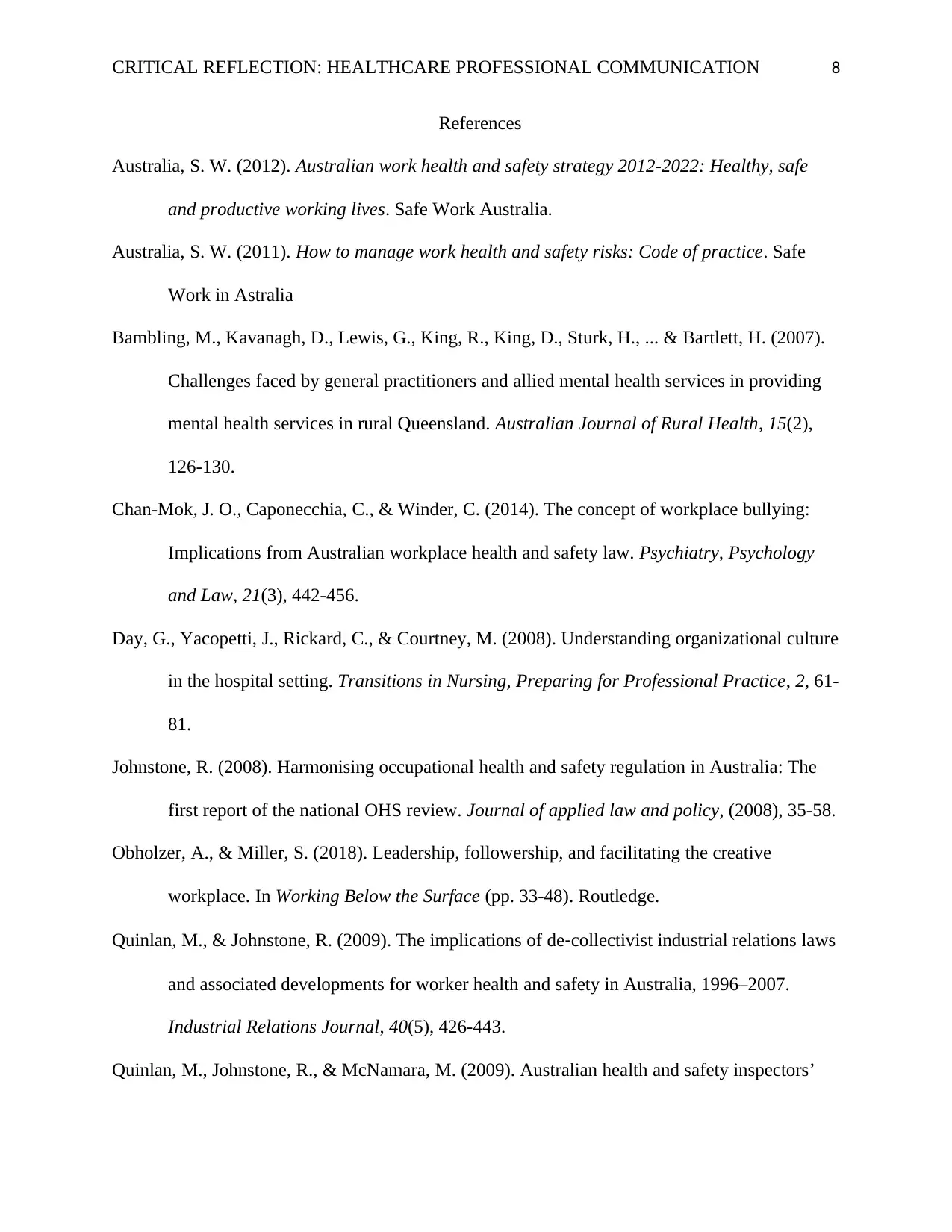
CRITICAL REFLECTION: HEALTHCARE PROFESSIONAL COMMUNICATION 8
References
Australia, S. W. (2012). Australian work health and safety strategy 2012-2022: Healthy, safe
and productive working lives. Safe Work Australia.
Australia, S. W. (2011). How to manage work health and safety risks: Code of practice. Safe
Work in Astralia
Bambling, M., Kavanagh, D., Lewis, G., King, R., King, D., Sturk, H., ... & Bartlett, H. (2007).
Challenges faced by general practitioners and allied mental health services in providing
mental health services in rural Queensland. Australian Journal of Rural Health, 15(2),
126-130.
Chan-Mok, J. O., Caponecchia, C., & Winder, C. (2014). The concept of workplace bullying:
Implications from Australian workplace health and safety law. Psychiatry, Psychology
and Law, 21(3), 442-456.
Day, G., Yacopetti, J., Rickard, C., & Courtney, M. (2008). Understanding organizational culture
in the hospital setting. Transitions in Nursing, Preparing for Professional Practice, 2, 61-
81.
Johnstone, R. (2008). Harmonising occupational health and safety regulation in Australia: The
first report of the national OHS review. Journal of applied law and policy, (2008), 35-58.
Obholzer, A., & Miller, S. (2018). Leadership, followership, and facilitating the creative
workplace. In Working Below the Surface (pp. 33-48). Routledge.
Quinlan, M., & Johnstone, R. (2009). The implications of de‐collectivist industrial relations laws
and associated developments for worker health and safety in Australia, 1996–2007.
Industrial Relations Journal, 40(5), 426-443.
Quinlan, M., Johnstone, R., & McNamara, M. (2009). Australian health and safety inspectors’
References
Australia, S. W. (2012). Australian work health and safety strategy 2012-2022: Healthy, safe
and productive working lives. Safe Work Australia.
Australia, S. W. (2011). How to manage work health and safety risks: Code of practice. Safe
Work in Astralia
Bambling, M., Kavanagh, D., Lewis, G., King, R., King, D., Sturk, H., ... & Bartlett, H. (2007).
Challenges faced by general practitioners and allied mental health services in providing
mental health services in rural Queensland. Australian Journal of Rural Health, 15(2),
126-130.
Chan-Mok, J. O., Caponecchia, C., & Winder, C. (2014). The concept of workplace bullying:
Implications from Australian workplace health and safety law. Psychiatry, Psychology
and Law, 21(3), 442-456.
Day, G., Yacopetti, J., Rickard, C., & Courtney, M. (2008). Understanding organizational culture
in the hospital setting. Transitions in Nursing, Preparing for Professional Practice, 2, 61-
81.
Johnstone, R. (2008). Harmonising occupational health and safety regulation in Australia: The
first report of the national OHS review. Journal of applied law and policy, (2008), 35-58.
Obholzer, A., & Miller, S. (2018). Leadership, followership, and facilitating the creative
workplace. In Working Below the Surface (pp. 33-48). Routledge.
Quinlan, M., & Johnstone, R. (2009). The implications of de‐collectivist industrial relations laws
and associated developments for worker health and safety in Australia, 1996–2007.
Industrial Relations Journal, 40(5), 426-443.
Quinlan, M., Johnstone, R., & McNamara, M. (2009). Australian health and safety inspectors’

CRITICAL REFLECTION: HEALTHCARE PROFESSIONAL COMMUNICATION 9
perceptions and actions in relation to changed work arrangements. Journal of Industrial
Relations, 51(4), 557-573.
Queensland Work Health and Safety Act 2011 (Qld) p. 2 d. 2.19 [Retrieved from]
https://www.legislation.qld.gov.au/view/pdf/2017-11-13/act-2011-018. Accessed
8/9/2018
Safe Work Australia. (2017). 2015-16 Australian Workers’ Compensation Statistics [Retrieved
from] Retrieved from https://www.safeworkaustralia.gov.au/collection/australian-
workers-compensation-statistics. Accessed 8/9/2018
Taylor, J. (2008). Organizational influences, public service motivation, and work outcomes: An
Australian study. International Public Management Journal, 11(1), 67-88.
perceptions and actions in relation to changed work arrangements. Journal of Industrial
Relations, 51(4), 557-573.
Queensland Work Health and Safety Act 2011 (Qld) p. 2 d. 2.19 [Retrieved from]
https://www.legislation.qld.gov.au/view/pdf/2017-11-13/act-2011-018. Accessed
8/9/2018
Safe Work Australia. (2017). 2015-16 Australian Workers’ Compensation Statistics [Retrieved
from] Retrieved from https://www.safeworkaustralia.gov.au/collection/australian-
workers-compensation-statistics. Accessed 8/9/2018
Taylor, J. (2008). Organizational influences, public service motivation, and work outcomes: An
Australian study. International Public Management Journal, 11(1), 67-88.
1 out of 9
Related Documents
Your All-in-One AI-Powered Toolkit for Academic Success.
+13062052269
info@desklib.com
Available 24*7 on WhatsApp / Email
![[object Object]](/_next/static/media/star-bottom.7253800d.svg)
Unlock your academic potential
© 2024 | Zucol Services PVT LTD | All rights reserved.




